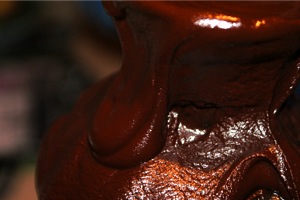Many materials do not really fall into the neat category of a fluid or a solid. May be the most common material is corn starch powder, which when you mix it with only a little water makes a material that can be flaked with a fork, but that subsequently flows like water.
In the picture above you can see chocolate in a chocolate fountain after the heater in the fountain has been turned off. Most of the chocolate is essentially solid at the point but some has spilled over the lip of the container and, under the action of gravity flows in a drop like form. The drop will eventually solidify completely, much the way lava outflows from a volcano become a petrified river of rock.
Viscoelastic theories account for the in between solid and fluid nature of the material by incorporating the past states of the material into the description. This yields governing equations that involve partial derivatives and integrals of convolution form in time.
Whether a viscoelastic material behaves as a fluid or a solid is determined by a dimensionless parameter called the Deborah number, which is a ratio of the relaxation timescale for the material and the timescale of the forcing. For example on long time scales the Earth behaves as a fluid, leading to the phenomenon of isostatic rebound in which the Earth is responding to the disappearance of overlying ice sheets that have been gone for more than ten thousand years. This leads to the phenomenon of raised beaches, as found in the cast Hudson Bay Lowlands of Northern Ontario, that were beneath the giant Laurentide Ice Sheet during the last, or Wisconsian Glacial Period.
Viscoelasticity



